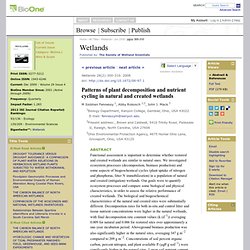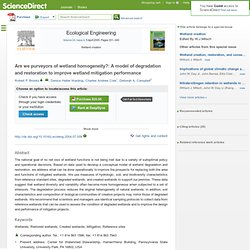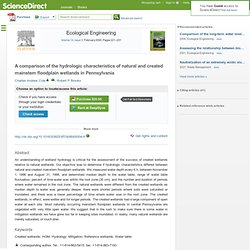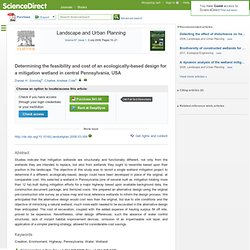

Hemet/San Jacinto Multipurpose Constructed Wetlands Project. The Hemet/San Jacinto Multipurpose Constructed Wetlands was designed to focus on reclaimed water treatment, migratory and resident waterfowl and shorebird habitat enhancement, wildlife diversity, and public education and recreation opportunities.

A cooperative effort by the US Bureau of Reclamation, the National Biologic Service, and the Eastern Municipal Water District, the one million gallons/day system occupies about 26 acres of the 50 acre site. The design is a three phase (marsh/pond/marsh) integrated system consisting of five separate wetlands treatment units, a combined open water and marsh habitat area, and a final polishing wetlands. Secondary reclaimed water from the H/SJ RWRF is distributed to the five wetland treatment units, then is recombined in the central area to flow thorough the open pond prior to flowing through the final wetland which combines all flows to remove biological input produced in the open water area. Benefits: Environmental Benefits: Other Benefits: Maine. Fifty-five years of soil development in restored f... [Ecol Appl. 2009] - PubMed result.
Temporal and spatial development of surface soil c... [J Environ Qual. 2005] - PubMed result. Soil development and establishment of carbon-based... [Ecol Appl. 2010] - PubMed result. THE EFFECTS OF ADJACENT LAND USE ON WETLAND SPECIES RICHNESS AND COMMUNITY COMPOSITION. Patterns of plant decomposition and nutrient cycling in natural and created wetlands. Aber, J.D. and J.M.

Melillo. 1991. Terrestrial Ecosystems. Philadelphia, PA, USA Saunders College Publishing. Aerts, R. and H. de Caluwe. 1997. Initial litter respiration as indicator for long-term leaf litter decomposition of Carex species. Convergence and divergence in plant community trajectories as a framework for monitoring wetland restoration progress - Matthews - 2010 - Journal of Applied Ecology. Ecological Engineering : Are we purveyors of wetland homogeneity? : : A model of degradation and restoration to improve wetland mitigation performance. Abstract The national goal of no net loss of wetland functions is not being met due to a variety of suboptimal policy and operational decisions.

Based on data used to develop a conceptual model of wetland degradation and restoration, we address what can be done operationally to improve the prospects for replacing both the area and functions of mitigated wetlands. We use measures of hydrologic, soil, and biodiversity characteristics from reference standard sites, degraded wetlands, and created wetlands to support our premise.
These data suggest that wetland diversity and variability often become more homogeneous when subjected to a set of stressors. The degradation process reduces the original heterogeneity of natural wetlands. Keywords. Ecological Engineering : A comparison of the hydrologic characteristics of natural and created mainstem floodplain wetlands in Pennsylvania. Abstract An understanding of wetland hydrology is critical for the assessment of the success of created wetlands relative to natural wetlands.

Our objective was to determine if hydrologic characteristics differed between natural and created mainstem floodplain wetlands. We measured water depth every 6 h, between November 1, 1996 and August 31, 1998, and determined median depth to the water table, range of water table fluctuation, percent of time water was within the root zone (30 cm), and the number and duration of periods where water remained in the root zone. The natural wetlands were different from the created wetlands as median depth to water was generally deeper, there were shorter periods where soils were saturated or inundated, and there was a lower percentage of time where water was in the root zone.
The created wetlands, in effect, were wetter and for longer periods. Keywords. Landscape and Urban Planning : Determining the feasibility and cost of an ecologically-based design for a mitigation wetland in central Pennsylvania, USA. Abstract Studies indicate that mitigation wetlands are structurally and functionally different, not only from the wetlands they are intended to replace, but also from wetlands they ought to resemble based upon their position in the landscape.

The objective of this study was to revisit a single wetland mitigation project to determine if a different, ecologically-based, design could have been developed in place of the original, at comparable cost. We selected a wetland in Pennsylvania (one of several built as mitigation totaling more than 12 ha) built during mitigation efforts for a major highway based upon available background data, the construction document package, and itemized costs. We prepared an alternative design using the original pre-construction site survey as a base map and local reference wetlands to inform the design process. Keywords Creation; Environment; Highway; Pennsylvania; Water; Wetland Copyright © 2008 Elsevier B.V.